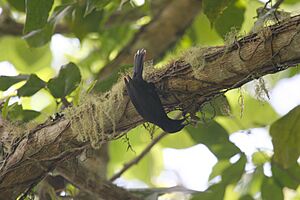Jamaican blackbird facts for kids
Quick facts for kids Jamaican blackbird |
|
|---|---|
 |
|
| Conservation status | |
| Scientific classification | |
| Genus: |
Nesopsar
|
| Species: |
nigerrimus
|
The Jamaican blackbird (Nesopsar nigerrimus) is a special type of bird. It belongs to the family of New World blackbirds and orioles, called Icteridae. This bird is the only species in its genus Nesopsar. It lives only in Jamaica, which means it is endemic there. You can find it in places like Cockpit Country and the Blue and John Crow Mountains.
Contents
What Does the Jamaican Blackbird Look Like?
The Jamaican blackbird is a small bird. It has shiny black feathers all over its body. Its tail is short and often looks a bit spread out.
Where Do Jamaican Blackbirds Live?
These birds live only in trees. They make a sound like a wheezing call. A pair of blackbirds will claim a large area for themselves.
They prefer wet montane forests, which are forests found in mountains. These include elfin and mist forests. These forests have many epiphytes (plants that grow on other plants, like air plants) and mosses on the trees. Jamaican blackbirds are usually found in areas above 575 meters (about 1,886 feet) high. They are rarely seen in lower areas.
How Do Jamaican Blackbirds Find Food?
The Jamaican blackbird has a special way of finding food. In Jamaica, there are not many birds like woodcreepers or woodpeckers that dig into tree trunks for food. Because of this, the Jamaican blackbird has evolved to fill this special job. This is called an ecological niche.
Most of their food is found on tree trunks and inner branches. They eat mostly insects. They find these insects hidden in the bark or inside plants like bromeliads.
To help them find food, they have shorter legs and longer claws than other blackbirds. They use their tail to help them climb tree trunks. Their bill is longer and their jaw muscles are stronger. This helps them probe, spread, and hammer into wood to find food. Another bird, the Jamaican oriole, also lives in Jamaica. But it looks for food mainly on the outer branches of trees.
Why Are Jamaican Blackbirds Endangered?
The biggest danger to the Jamaican blackbird is habitat loss. This means their forest homes are disappearing. Many things threaten Jamaica's forests. These include bauxite mining (digging for a mineral), making charcoal, forestry (cutting down trees), farming, and new buildings.
This bird is especially at risk because it needs large trees. These trees support the many epiphytes and mosses where the blackbirds find their food. Because of these dangers, the IUCN (International Union for Conservation of Nature) lists the Jamaican blackbird as Endangered.
Good news is that the bird is protected in the Blue and John Crow Mountains National Park. Also, people are working to stop bauxite mining in Cockpit Country to help save their homes.


